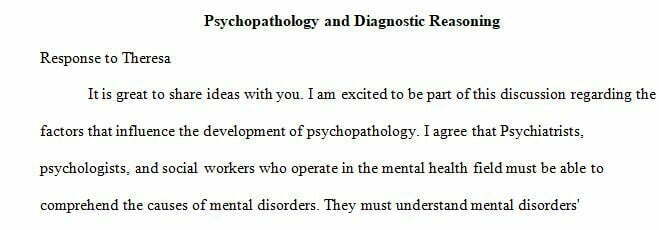Factors That Influence the Development of Psychopathology.
Factors That Influence the Development of Psychopathology. Your Topic: Psychopathology and diagnostic-reasoning
Assignment Details: response to Theresa Factors That Influence the Development of Psychopathology.
The study of mental illnesses and unusual or maladaptive actions is known as psychopathology or abnormal psychology. Psychiatrists, psychologists, and social workers who operate in the mental health field must be able to comprehend the causes of mental disorders. The distinction between dysfunctional, aberrant, and simply idiosyncratic behaviors is a contentious issue in psychopathology (Britannica, 2017). This discussion explains how Psychopathological development is influenced by biological, i.e., genetic and neuroscientific; psychological, i.e., behavioral and cognitive processes, emotional, developmental, social, cultural, and interpersonal factors.
The human brain controls all our cognitive functions, feelings, and behaviors—everything we think, experience, and do—. The brain is the ultimate integrator of these influences, even though many factors (such as epigenetic, environmental, and psychosocial experiences) influence the brain’s early development and adult function. Despite the numerous advancements in neural sciences, treating mental illnesses has not significantly improved in over 50 years (Boland et al., 2022). Psychotherapy is an interpersonal process that alters disturbing thoughts, emotions, behaviors, and attitudes toward someone seeking medical assistance. Psychological and biological variables are related, according to studies on mental disorders. Everyone agrees that psychotherapy entails a particular kind of learning within the framework of an emotional relationship that may result in epigenetic changes across various therapeutic approaches (Jimenez et al., 2018). Studies show that childhood and adolescent disorders are associated with mental health genes. This gene makes some youth in families susceptible to mental illnesses through genetic transmissions (Butcher & Kendall, 2018).
The main idea in cognitive therapy is that the patient has, over the years, developed certain strong beliefs about themselves and has conditional probability beliefs due to developmental experiences. Individual development experiences contribute to emotional or behavioral problems in their life. For instance, a depressed patient might believe they are unlovable. Substance abuse patients might think drugs are the only thing that gives them happiness. The purpose of cognitive therapy is to assist the person in identifying the negative automatic thoughts and other underlying dysfunctional thoughts or beliefs that contribute to emotional distress or other harmful behavior. The critical therapeutic process after identification of the maladaptive thoughts is to help the patient view these thoughts more objectively, not unquestioningly consider them as truthful. Here, cognitive therapy emphasizes evidence consistent with Piaget’s theory of cognitive development. The nurse practitioner assists the patient in seeking evidence to test negative thinking; active involvement, rather than passive listening, is required (Boland et al., 2022).
Psychopathology is ingrained in systems of meaning and values that are socially and culturally based, unlike mental diseases, which share universal traits. Social and cultural differences influence the development, expression, classification, and management of symptom experiences (Cheung & Mak, 2018). Theories of culture and psychopathology have analyzed the variations in psychopathology among cultures and examined how culture affects or determines the conditions resulting from mental diseases. In contrast to the thesis of cultural determinism, cultural relativism argues that cultural variation may explain the variety of mental illnesses, the array of symptoms displayed in those disorders, or the determination of what defines pathology (Cheung & Mak, 2018).
Conclusion
Various studies show that Psychopathological development is influenced by biological (genetic and neuroscientific); psychological (behavioral and cognitive processes, emotional, developmental); and social, cultural, and interpersonal factors. The nurse practitioner should ensure to gain the trust of their patients and their families irrespective of their social and economic background.
Reference
Boland, R. & Verduin, M. L. & Ruiz, P. (2022). Kaplan & Sadock’s synopsis of psychiatry (12th ed.). Wolters Kluwer.
Britannica, T. Editors of Encyclopedia (2017, July 28). psychopathology. Encyclopedia Britannica. https://www.britannica.com/science/psychopathologyLinks to an external site.
Butcher, J. N., & Kendall, P. C. (2018). Introduction to childhood and adolescent psychopathology. In J. N. Butcher & P. C. Kendall (Eds.), APA handbook of psychopathology: Child and adolescent psychopathology Links to an external site., Vol. 2. (pp. 3–14). American Psychological Association. https://go.openathens.net/redirector/waldenu.edu?url=https://doi.org/10.1037/0000065-001 links to an external site.
Cheung, F. M., & Mak, W. W. S. (2018). Sociocultural factors in psychopathology. In J. N. Butcher & J. M. Hooley (Eds.), APA handbook of psychopathology: Psychopathology: Understanding, assessing, and treating adult mental disorders., Vol. 1Links to an external site (pp. 127–147). American Psychological Association. https://go.openathens.net/redirector/waldenu.edu?url=https://doi.org/10.1037/0000064-006Links to an external site.
Jimenez, J. P., Botto, A., & luyten, P. (2018). Psychotherapy and Genetic Neuroscience: An emerging dialog. https://www.ncbi.nih.gov/pmc/articles/PMC6056612/ links to an external site..
Masten, A. S., & Kalstabakken, A. W. (2018). Developmental perspectives on psychopathology in children and adolescents. In J. N. Butcher & P. C. Kendall (Eds.), APA handbook of psychopathology: Child and adolescent psychopathology., Vol. 2 Links to an external site. (pp. 15–36). American Psychological Association. https://go.openathens.net/redirector/waldenu.edu?url=https://doi.org/10.1037/0000065-002 Links to an external site.
Preferred Format: APA
Number of Sources: 2
Number of Pages: 1
PowerPoint slides:
Preferred Spacing: Double spaced
Answer preview for the paper on ‘Factors That Influence the Development of Psychopathology’

APA 502 words
Click the purchase button below to download the full answer…….
